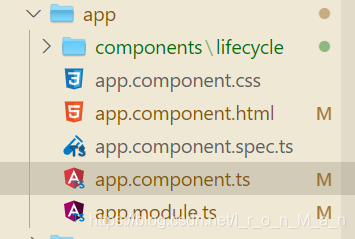生命周期:官方文档:
- 生命周期函数通俗的讲就是组件创建、组件更新、组件销毁的时候会触发的一系列的方法。
- 当 Angular 使用构造函数新建一个组件或指令后,就会按下面的顺序在特定时刻调用这些生命周期钩子方法。
- constructor() 构造函数中除了使用简单的值对局部变量进行初始化 之外,什么都不应该做。 (非生命周期函数)
Angular 中的生命周期函数

生命周期示例:
1. 创建1个组件:lifecycle
ng g component components/lifecycle
2. 定义组件

lifecycle.component.html
<h2>{
{
msg}}</h2>
<br>
<button (click)="changeMsg()">改变msg的值</button>
<input type="text" [(ngModel)]="userinfo" />

lifecycle.component.ts
import {
Component, OnInit, Input } from '@angular/core';
@Component({
selector: 'app-lifecycle',
templateUrl: './lifecycle.component.html',
styleUrls: ['./lifecycle.component.css'],
})
export class LifecycleComponent implements OnInit {
@Input('title') title: string;
public msg: string = '我是一个生命周期演示';
public userinfo: string = '';
public oldUserinfo: string = '';
constructor() {
console.log(
'00构造函数执行了---除了使用简单的值对局部变量进行初始化之外,什么都不应该做'
);
}
ngOnChanges() {
console.log(
'01ngOnChages执行了---当被绑定的输入属性的值发生变化时调用(父子组件传值的时候会触发)'
);
}
ngOnInit() {
console.log('02ngOnInit执行了--- 请求数据一般放在这个里面');
}
ngDoCheck() {
//写一些自定义的操作
console.log(
'03ngDoCheck执行了---检测,并在发生 Angular 无法或不愿意自己检测的变化时作出反应'
);
if (this.userinfo !== this.oldUserinfo) {
console.log(`你从${
this.oldUserinfo}改成${
this.userinfo}`);
this.oldUserinfo = this.userinfo;
} else {
console.log('数据没有变化');
}
}
ngAfterContentInit() {
console.log('04ngAfterContentInit执行了---当把内容投影进组件之后调用');
}
ngAfterContentChecked() {
console.log(
'05ngAfterContentChecked执行了---每次完成被投影组件内容的变更检测之后调用'
);
}
ngAfterViewInit(): void {
console.log(
'06 ngAfterViewInit执行了----初始化完组件视图及其子视图之后调用(dom操作放在这个里面)'
);
}
ngAfterViewChecked() {
console.log(
'07ngAfterViewChecked执行了----每次做完组件视图和子视图的变更检测之后调用'
);
}
ngOnDestroy() {
console.log('08ngOnDestroy执行了····');
}
//自定义方法
changeMsg() {
this.msg = '数据改变了';
}
}
3. 引入双向数据绑定模块

app.moudule.ts
import {
NgModule } from '@angular/core';
import {
BrowserModule } from '@angular/platform-browser';
//双向数据绑定必须引入
import {
FormsModule } from '@angular/forms';
import {
AppComponent } from './app.component';
import {
LifecycleComponent } from './components/lifecycle/lifecycle.component';
@NgModule({
declarations: [AppComponent, LifecycleComponent],
imports: [BrowserModule, FormsModule],
providers: [],
bootstrap: [AppComponent],
})
export class AppModule {
}
4. 根主键(父组件)定义方法

app.component.ts
import {
Component } from '@angular/core';
@Component({
selector: 'app-root',
templateUrl: './app.component.html',
styleUrls: ['./app.component.css'],
})
export class AppComponent {
title = 'angulardemo07';
public flag: boolean = true;
changeTilte() {
this.title = '改变后的title';
}
changeFlag() {
this.flag = !this.flag;
}
}
5. 引入组件

app.component.html
<app-lifecycle></app-lifecycle>
6. 运行程序
命令行输入:
ng serve --open
运行结果:


